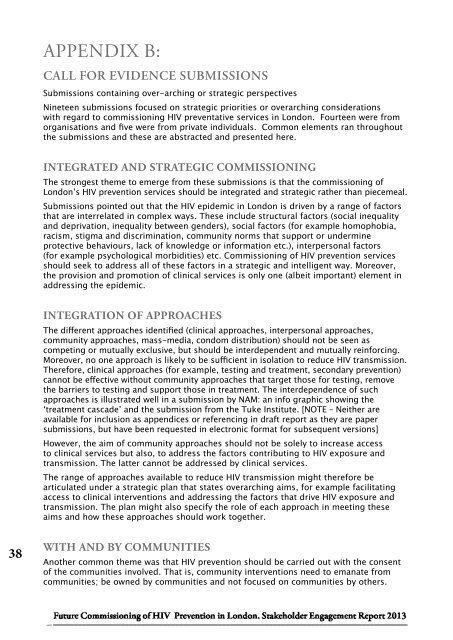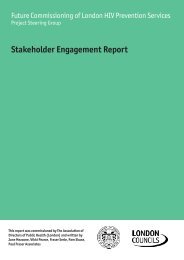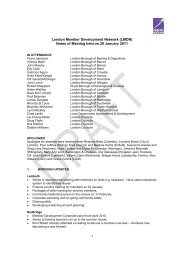Stakeholder Engagement Report - London Councils
Stakeholder Engagement Report - London Councils
Stakeholder Engagement Report - London Councils
You also want an ePaper? Increase the reach of your titles
YUMPU automatically turns print PDFs into web optimized ePapers that Google loves.
Appendix B:<br />
Call for Evidence submissions<br />
Submissions containing over-arching or strategic perspectives<br />
Nineteen submissions focused on strategic priorities or overarching considerations<br />
with regard to commissioning HIV preventative services in <strong>London</strong>. Fourteen were from<br />
organisations and five were from private individuals. Common elements ran throughout<br />
the submissions and these are abstracted and presented here.<br />
Integrated and Strategic Commissioning<br />
The strongest theme to emerge from these submissions is that the commissioning of<br />
<strong>London</strong>’s HIV prevention services should be integrated and strategic rather than piecemeal.<br />
Submissions pointed out that the HIV epidemic in <strong>London</strong> is driven by a range of factors<br />
that are interrelated in complex ways. These include structural factors (social inequality<br />
and deprivation, inequality between genders), social factors (for example homophobia,<br />
racism, stigma and discrimination, community norms that support or undermine<br />
protective behaviours, lack of knowledge or information etc.), interpersonal factors<br />
(for example psychological morbidities) etc. Commissioning of HIV prevention services<br />
should seek to address all of these factors in a strategic and intelligent way. Moreover,<br />
the provision and promotion of clinical services is only one (albeit important) element in<br />
addressing the epidemic.<br />
Integration of approaches<br />
The different approaches identified (clinical approaches, interpersonal approaches,<br />
community approaches, mass-media, condom distribution) should not be seen as<br />
competing or mutually exclusive, but should be interdependent and mutually reinforcing.<br />
Moreover, no one approach is likely to be sufficient in isolation to reduce HIV transmission.<br />
Therefore, clinical approaches (for example, testing and treatment, secondary prevention)<br />
cannot be effective without community approaches that target those for testing, remove<br />
the barriers to testing and support those in treatment. The interdependence of such<br />
approaches is illustrated well in a submission by NAM: an info graphic showing the<br />
‘treatment cascade’ and the submission from the Tuke Institute. [NOTE – Neither are<br />
available for inclusion as appendices or referencing in draft report as they are paper<br />
submissions, but have been requested in electronic format for subsequent versions]<br />
However, the aim of community approaches should not be solely to increase access<br />
to clinical services but also, to address the factors contributing to HIV exposure and<br />
transmission. The latter cannot be addressed by clinical services.<br />
The range of approaches available to reduce HIV transmission might therefore be<br />
articulated under a strategic plan that states overarching aims, for example facilitating<br />
access to clinical interventions and addressing the factors that drive HIV exposure and<br />
transmission. The plan might also specify the role of each approach in meeting these<br />
aims and how these approaches should work together.<br />
38<br />
With and by communities<br />
Another common theme was that HIV prevention should be carried out with the consent<br />
of the communities involved. That is, community interventions need to emanate from<br />
communities; be owned by communities and not focused on communities by others.




